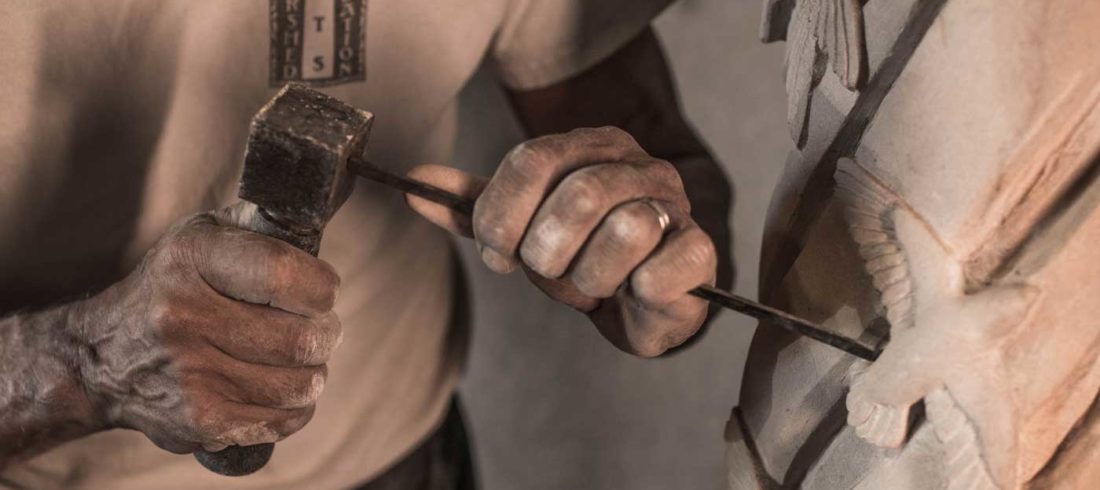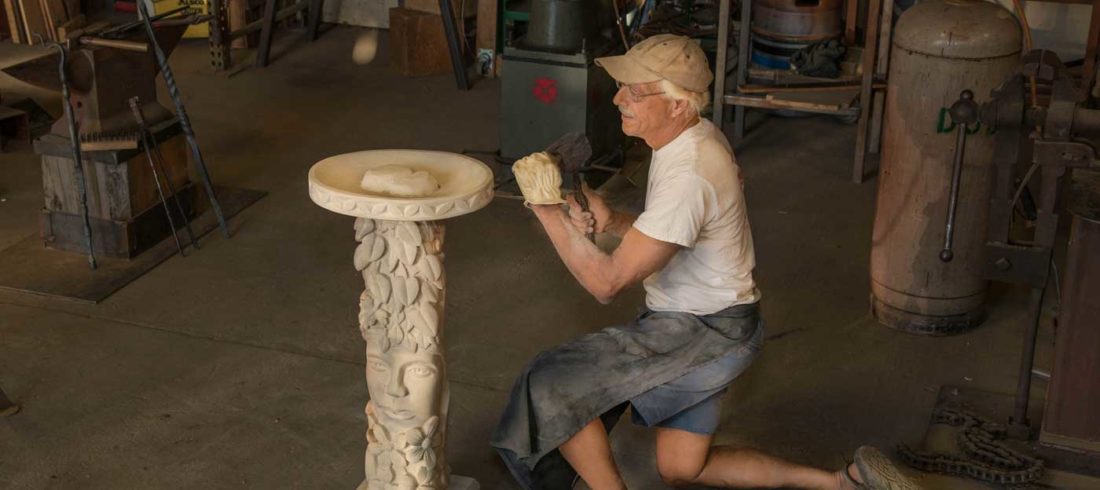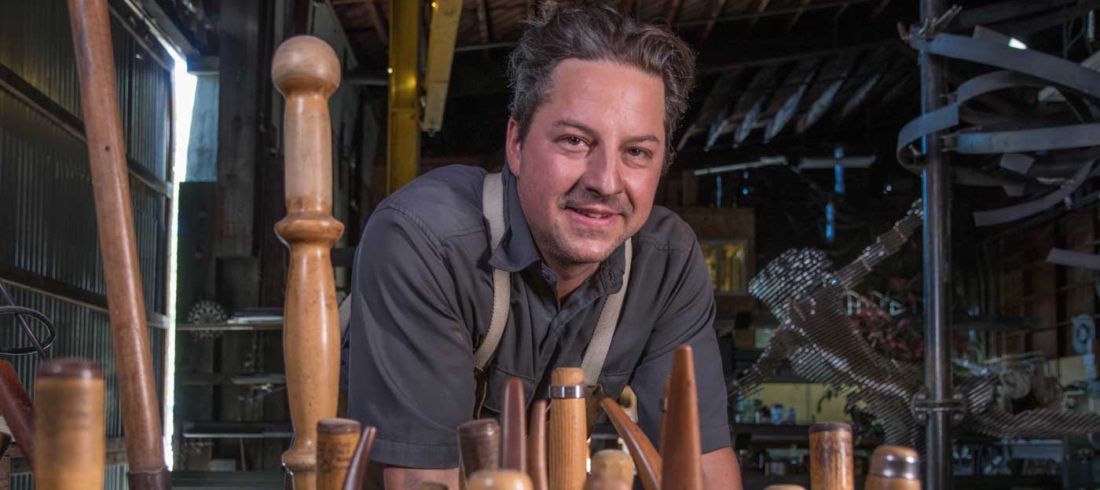Three of a kind: Cedar Caredio, Mark Andrew, Randy Ortiz .
Each a skilled sculptor, each has carved out a unique artistic style, each favors a specific material, all three work under the same roof.
Still, their differences are remarkable.
Tucked away among the myriad nondescript industrial buildings on the west end of Eugene stands a particular open-beamed warehouse. The exterior has been bleached by the sun. The three-story-high sliding metal doors suggest the building may have once served as a lumber storage facility or a mill. The building’s rough-hewn interior likely once housed raw steel or timber stacked alongside industrial machinery.

These days, things are not all that changed—except that the building’s primary duty is as a sculpture studio. The tools on display are largely hand tools. The machinery is of modest dimensions. All of the merchandise stored inside the warehouse reflects service to the creation of art.
It is now home to three sculptors who are different in their approaches and materials, but who have still found teammates in each other.
“The nice thing about the three of us coming together in this space is that we began collaborating,” Andrew says. “And the collaboration worked really well. All of us had design backgrounds. All of us had been making things for years. We began sharing ideas and problem-solving our individual projects. Suddenly our goods started getting better.”
Ortiz nods firmly in agreement. Metals are currently his most favored materials, but he has experience and a repertoire of skills shaped by working with a variety of other media. He was the first of the three sculptors to set up shop in the warehouse.

“Collaboration happens here every day,” offers Ortiz. “We go looking for feedback, for critique. Getting that’s a challenge when you work in isolation. Providing feedback is one of our biggest intersections. Sometimes it starts as a little stir, but then it can become a current.”
Not surprisingly, each member of the Eugene Sculpture Group trio arrived at his present artistic state by following a markedly different path.
Caredio, for example: unlike Andrew and Ortiz, he made the big commitment to his craft relatively late in life. He taught grade school for 33 years, at the same time dabbling in woodcarving at home.
“While I was a teacher, I was always doing personal art projects, working with my hands,” he says. “It was a nice escape from all the time I spent in my head when teaching.”
In the ’80s, Caredio met Dudley Carter, a renowned 90-year-old woodcarver in Redmond, Washington, who took him on as an apprentice. Caredio says the tutelage provided him valuable hand-tool techniques while inspiring a deep passion for woodcarving. That passion often translates into designs that favor Celtic and native Northwest lore realized through masks and totems depicting stylized animals and mythical creatures. Caredio’s pieces are more about defining lines than intricate detail.

In contrast to Caredio, Andrew found his passion for art during his teen years when, as a high school student, he traveled around Europe and encountered classic architecture and sculpture.
“I wanted to get on the art train,” he says. “I realized that life is temporary, but art can last for a long time.” The experience even spoke to his choice of materials. “I wanted to produce art that outlived me and produced maximum good,” he explains. “That’s why I went with the harder materials—bronzes, marbles, granites—so that my art would last longer.”
Andrew’s art training included coursework at the University of Oregon and formal studies with a wildlife artist, a figure sculptor, and a fine furniture craftsman. Those varied streams are reflected in his work, allowing the viewer to witness Andrew’s appreciation for classic expressions of beauty: delicate flowers and foliage, rich landscape elements, detailed animal and human forms.
Why sculpture? “There’s a certain sort of thrill that comes from doing something unusual,” Andrew says, “a thrill that comes with doing things that nobody else is doing.”
The same sentiment can certainly be applied to the art produced by Ortiz. While Andrew and Caredio are typically creating art through reduction—chiseling, carving, chipping—Ortiz creates art by addition. He bends, welds, bolts, stacks, and builds. By his own admission, he’s an artist on a search mission.

“I think I’m still trying to discover what I do best,” he says. “A lot of my work is driven by my client’s tastes. I’m making what they want. When I’m on my own, I often go back to carving.”
Yet Ortiz’s commission work is often stunningly unique, large, and powerful. This is exemplified in the pair of bigger-than-life dancing garden figures constructed from dozens of cut steel wafers sandwiched together like a 3D jigsaw puzzle, or the massive spiral wheels designed to function as a road gate, intricately adorned with steel vines and flowers, or even the oddly elegant steel plate fire pit that Ortiz jokingly refers to as Gollum’s ring.
“We all want static pieces to come alive,” Ortiz says. “Maybe not all the time, but when I want to make a statement, I definitely go that route. It seems to me we all we want movement in our art.”
Andrew and Caredio confess they are of a like mind. Movement is a shared interest. So, too, is respect for the historical influences found in classical art. In many ways, they say, their choice to become sculptors was informed by their desire to carry historical artistic values into the future.
Appreciation, generosity, courage, beauty, patience, perseverance, love—turns out that the three sculptors share, along with their workshop, a wide palette of intentions with regards to the values they invest in their art.


